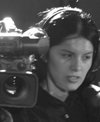
Mabel’s feature length script, is an intimate psychological portrait of a Chilean exile photographer in San Francisco, who goes back to Chile to bury her father’s bones and reconcile with her country's violent past. The script created great interest among the industry experts that came to Squaw Valley from Hollywood and the independent world to discover and nurture fresh voices.
“It was the most validating experience I have had so far as a writer and filmmaker,” says the Peruvian born filmmaker. During one of the sessions Mabel gathered with actors and together they stage-read a scene that she had been rewriting at the workshop. The results were dramatic. “It was the most truthful scene I have seen at Squaw,” declared Diane Fuller, program director of the Screenwriting Workshop.
Some mentors and guests at the program included: Tom Rickman (Squaw program co-founder/Coal Miner’s Daughter), Gene Corr (Waldo Salt), Pamela Gray (Walk on the Moon), Michael Lehmann (Heathers), Tom Schlesinger (Nowhere in Africa), Camille Thomasson (Ave Maria), Tamsin Orion (Tamzina Films), and esteemed guests Greg Beal, Sarah Ryan Beck, Gail Silva, Owen Prell, Peggy Rajski and Deborah Wettstein.

The dynamic filmmaker has launched her production company "Haiku Films", a diversity media company which is developing the narrative film "Soledad Is Gone Forever" (collaborating with the Film Arts Foundation). Also "Novo Latino", a unique TV show that features the culture, lifestyle and trends of the 3rd generation of Latinos living in the Bay Area and their impact on a multicultural US.
The project is currently seeking assistance from sponsors and donors, as well as an experienced bilingual lead actress. For more information about "Soledad", its progress and funding, please visit:
www.SoledadisGoneForever.com
www.HaikuFilms.org
www.SquawValleyWriters.org
Need a line of credit up to $100,000? Click here.
























